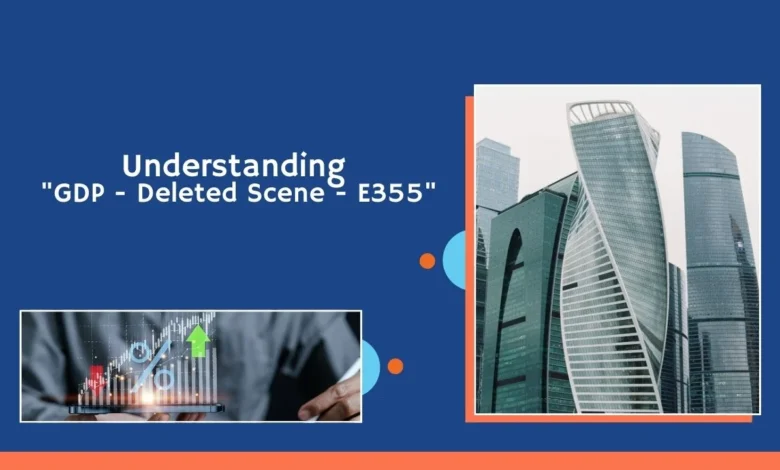Understanding “GDP – Deleted Scene – E355”

GDP stands for Gross Domestic Product, which measures the total value of goods and services produced within a country’s borders in a specific time period. It is an essential tool to understand how well a country’s economy is performing. Economists and governments use GDP to compare economic health, set policies, and plan for the future.
The term “GDP – deleted scene – E355” is intriguing, as it suggests the possibility of missing or overlooked elements in the discussion about GDP, or perhaps a pop culture reference to something related to the economy. This article will explore what this term might imply and how it connects to the broader concept of GDP.
How Is GDP Calculated?
To calculate GDP, economists typically follow one of three methods:
- Production Approach: This method looks at the total value of goods and services produced in the country.
- Income Approach: This adds up all the incomes earned by individuals and businesses in the economy.
- Expenditure Approach: This measures all the money spent on goods and services in the country.
The formula for GDP is: GDP=C+I+G+(X−M)\text{GDP} = C + I + G + (X – M)GDP=C+I+G+(X−M) Where:
- CCC is consumer spending.
- III is business investment.
- GGG is government spending.
- XXX is exports, and
- MMM is imports.
Each approach gives insight into different aspects of economic activity. Knowing these helps in understanding the importance of tracking GDP accurately, and this ties into what could be meant by “GDP – deleted scene – E355.” Perhaps something is missing in how we traditionally calculate or interpret GDP.
What Could ‘Deleted Scene’ Imply in an Economic Context?
The term “deleted scene” usually refers to a part of a movie or show that was cut but can offer valuable context when included. If we apply this to economics, “GDP – deleted scene – E355” could mean there are elements of economic measurement that we overlook, similar to how deleted scenes add value to a film’s narrative.
In GDP calculations, certain factors might be missing. For example, GDP does not account for:
- Environmental Degradation: GDP might rise with increased production, but it doesn’t consider the harm caused to the environment in the process.
- Income Inequality: GDP gives an overall picture, but it doesn’t show how wealth is distributed. High GDP does not mean everyone is doing well.
- Quality of Life: GDP focuses on economic output but doesn’t measure people’s well-being or happiness.
The phrase “deleted scene” in this context could suggest these overlooked or hidden factors. These are vital considerations for a full understanding of a country’s economic and social health.
What Is the Impact of ‘E355’?
“E355” could refer to a code or a specific event, data point, or model tied to the concept of GDP. Perhaps it relates to a formulaic adjustment or a year in which a significant change occurred in GDP measurement methods.
It could also represent a sector or industry that plays a significant role in GDP but may not always be fully accounted for in traditional statistics. For example, the digital economy, informal sectors, and underground markets can be significant contributors but might not always appear in official GDP figures.
Is GDP Always the Best Measure of Economic Health?
GDP is a vital economic measure, but it’s not without its critics. Here are some arguments for and against GDP as a measure of a country’s prosperity:
| Pros | Cons |
|---|---|
| Easy to compare between countries | Doesn’t account for inequality |
| Simple to understand and widely used | Ignores environmental impacts |
| Provides a clear snapshot of economic output | Doesn’t measure quality of life |
| Useful for tracking economic growth over time | Doesn’t include unpaid work, like household chores |
While GDP is essential, other metrics like the Human Development Index (HDI) or Genuine Progress Indicator (GPI) might offer a more comprehensive understanding of economic health. This could be the “deleted scene” we’re missing when relying solely on GDP.
What Are Some Alternatives to GDP?
If GDP – deleted scene – E355 suggests gaps in traditional GDP measurement, it’s helpful to look at alternatives that address these gaps. Here are some alternatives:
- Human Development Index (HDI): HDI looks at more than just income. It also considers life expectancy and education levels. This gives a broader sense of how well people are living.
- Genuine Progress Indicator (GPI): GPI adjusts GDP by taking into account environmental costs, inequality, and well-being. It is often seen as a more accurate measure of real prosperity.
- Green GDP: This adjusts GDP to account for environmental damage and depletion of natural resources. It seeks to provide a clearer picture of sustainable economic growth.
These alternatives offer a way to fill in the gaps left by traditional GDP measurements, helping to explain what might be missing in the “deleted scene.”
Why Does GDP Growth Not Always Mean a Better Economy for Everyone?
When a country’s GDP grows, it often signals a stronger economy. But GDP doesn’t always show whether that growth benefits everyone equally. For instance:
- Unequal Wealth Distribution: Sometimes, GDP can grow, but only a small percentage of the population benefits. The rich get richer, while the poor might stay the same or even become worse off.
- Environmental Costs: High GDP can mean more factories, construction, and production, but it also often leads to more pollution and loss of natural resources.
- Overlooking Unpaid Work: Many people do unpaid work, like taking care of family members. While this work is valuable, it isn’t counted in GDP.
These are some of the “deleted scenes” in GDP – things that GDP doesn’t capture but are important for understanding the true state of the economy.
What Role Does Technology Play in GDP?
Technology has transformed how we produce, buy, and sell goods and services. While technology has boosted GDP in many ways, it also creates challenges for traditional GDP measurement. For example:
- Digital Economy: Many digital services, such as free apps and online platforms, provide value but don’t always appear in GDP.
- Automation: Technology has made production more efficient, but it has also led to job loss in some sectors, which may not always reflect well in GDP figures.
- Informal Economy: In many countries, a significant portion of the economy operates outside of official records. This informal economy can include everything from small roadside vendors to online freelancers. While these activities contribute to the economy, they often don’t appear in GDP calculations.
This may be part of what “GDP – deleted scene – E355” implies—the role of technology and the informal economy are key components that may not be fully visible in traditional GDP measurements.
How Can We Improve GDP Measurements?
If GDP is missing important factors, how can we improve the way it’s measured? Here are some suggestions:
- Include Environmental Costs: By adjusting GDP to account for pollution, resource depletion, and other environmental impacts, we could get a more accurate picture of sustainable growth.
- Account for Income Distribution: Modifying GDP to reflect wealth inequality would help show how economic growth is spread across the population.
- Measure Well-Being: Incorporating measures of happiness and life satisfaction alongside economic output could provide a fuller understanding of prosperity.
Improving GDP measurements would allow policymakers to make better decisions that benefit everyone, not just a few, and might capture what “GDP – deleted scene – E355” is hinting at.
Benefits of Broadening GDP Measurements
| Benefits | Explanation |
|---|---|
| More Accurate Reflection of Economic Health | Considering more factors gives a clearer view of the economy. |
| Better Policy Decisions | Knowing more about the real state of the economy leads to better planning. |
| Focus on Sustainability | Adjusting for environmental factors promotes long-term growth. |
| Greater Insight into Wealth Distribution | Including income inequality can help address social disparities. |
| Increased Well-Being Measurement | Incorporating quality of life factors can improve people’s lives. |
Conclusion
“GDP – deleted scene – E355” might suggest that there are missing elements in how we traditionally calculate GDP. While GDP is a useful tool for measuring economic output, it doesn’t capture everything. By considering alternatives or adjusting GDP to account for well-being, inequality, and environmental impacts, we can get a fuller picture of a country’s real prosperity. This way, we don’t miss any “deleted scenes” in the story of economic growth.




